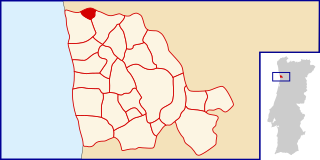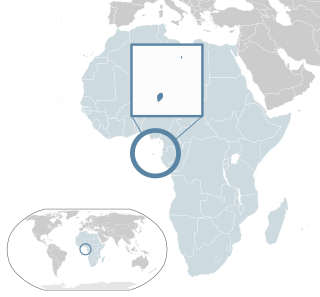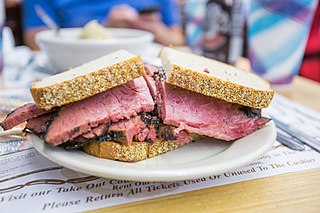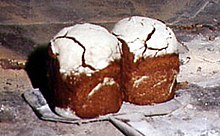
In North America, a corn tortilla or just tortilla is a type of thin, unleavened flatbread, made from hominy, that is the whole kernels of maize treated with alkali to improve their nutrition in a process called nixtamalization. A simple dough made of ground, dried hominy, salt and water is then formed into flat discs and cooked on a very hot surface, generally an iron griddle called a comal.

Finnish cuisine is notable for generally combining traditional country fare and haute cuisine with contemporary continental-style cooking. Fish and meat play a prominent role in traditional Finnish dishes in some parts of the country, while the dishes elsewhere have traditionally included various vegetables and mushrooms. Evacuees from Karelia contributed to foods in other parts of Finland in the aftermath of the Continuation War.

Cornbread is a quick bread made with cornmeal, associated with the cuisine of the Southern United States, with origins in Native American cuisine. It is an example of batter bread. Dumplings and pancakes made with finely ground cornmeal are staple foods of the Hopi people in Arizona. The Hidatsa people of the Upper Midwest call baked cornbread naktsi. Cherokee and Seneca tribes enrich the basic batter, adding chestnuts, sunflower seeds, apples, or berries, and sometimes combine it with beans or potatoes. Modern versions of cornbread are usually leavened by baking powder.

Latin American cuisine is the typical foods, beverages, and cooking styles common to many of the countries and cultures in Latin America. Latin America is a highly racially, ethnically, and geographically diverse with varying cuisines. Some items typical of Latin American cuisine include maize-based dishes arepas, empanadas, pupusas, tacos, tamales, tortillas and various salsas and other condiments. Sofrito, a culinary term that originally referred to a specific combination of sautéed or braised aromatics, exists in Latin American cuisine. It refers to a sauce of tomatoes, roasted bell peppers, garlic, onions and herbs. Rice, corn, pasta, bread, plantain, potato, yucca, and beans are also staples in Latin American cuisine.

The oldest known book on Portuguese cuisine, entitled Livro de Cozinha da Infanta D. Maria de Portugal, from the 16th century, describes many popular dishes of meat, fish, poultry and others.

Ukrainian cuisine is the collection of the various cooking traditions of the people of Ukraine, one of the largest and most populous European countries. It is heavily influenced by the rich dark soil (chornozem) from which its ingredients come, and often involves many components. Traditional Ukrainian dishes often experience a complex heating process – "at first they are fried or boiled, and then stewed or baked. This is the most distinctive feature of Ukrainian cuisine".

A gordita in Mexican cuisine is a dish made with masa and stuffed with cheese, meat, or other fillings. It is similar to the Colombian and Venezuelan arepa. Gordita means "chubby" in Spanish. There are two main variations of this dish, one of which is typically fried in a deep wok-shaped comal, consumed mostly in central and southern Mexico, and another one baked on a regular comal. The most common and representative variation of this dish is the "gordita de chicharrón", filled with chicharron which is widely consumed throughout Mexico. Gorditas are often eaten as a lunch dish and accompanied by several types of sauce.

Rye bread is a type of bread made with various proportions of flour from rye grain. It can be light or dark in color, depending on the type of flour used and the addition of coloring agents, and is typically denser than bread made from wheat flour. Compared to white bread, it is higher in fiber, darker in color, and stronger in flavor. The world's largest exporter of rye bread is Poland.

Broa is a type of corn and rye bread traditionally made in Portugal, Galicia, Angola, Mozambique, Cape Verde and Brazil, however in those countries it is more closely related to cornbread and its original recipe from Native Americans, where it is traditionally seasoned with fennel. Broa is made from a mixture of cornmeal and rye or wheat flour, and is leavened with yeast rather than baking powder or baking soda.

São Pedro da Afurada is a former civil parish in the municipality of Vila Nova de Gaia, Portugal. In 2013, the parish merged into the new parish Santa Marinha e São Pedro da Afurada. The population in 2011 was 3,568, in an area of 1.00 km².

Chilean cuisine stems mainly from the combination of traditional Spanish cuisine, Chilean Mapuche culture and local ingredients, with later important influences from other European cuisines, particularly from Germany, the United Kingdom and France. The food tradition and recipes in Chile are notable for the variety of flavours and ingredients, with the country's diverse geography and climate hosting a wide range of agricultural produce, fruits and vegetables. The long coastline and the peoples' relationship with the Pacific Ocean add an immense array of seafood to Chilean cuisine, with the country's waters home to unique species of fish, molluscs, crustaceans and algae, thanks to the oxygen-rich water carried in by the Humboldt Current. Chile is also one of the world's largest producers of wine and many Chilean recipes are enhanced and accompanied by local wines. The confection dulce de leche was invented in Chile and is one of the country's most notable contributions to world cuisine.

Avintes is a Portuguese civil parish in the municipality of Vila Nova de Gaia. The population in 2021 was 10,838, in an area of 8.82 km2. It is known in Portugal as "Terra da Broa", meaning "Land of the Broa", referring to the Broa de Avintes, a typical farmhouse bread widely consumed in Northern Portugal, which originated in Avintes.

Mamón are traditional Filipino chiffon or sponge cakes, typically baked in distinctive cupcake-like molds. In the Visayas regions, mamón are also known as torta mamón or torta. Variants of mamón include the larger loaf-like version called taisan, the rolled version called pianono, and ladyfingers known as broas. Mamón also has two very different variants that use mostly the same ingredients, the cookie-like mamón tostado and the steamed puto mamón.

Bread is a staple food throughout Europe. Throughout the 20th century, there was a huge increase in global production, mainly due to a rise in available, developed land throughout Europe, North America and Africa.
Boroña is a type of bread made with corn in northern Spain. This cornbread is a bread made with cornmeal. It is a traditional food from the regions of Galicia, Asturias, Cantabria, the Basque Country and northern Castilla-Leon, Spain. It has been widely used in rural areas until the mid twentieth century. It is usually cooked in an oven wrapped in cabbage leaves.

Santomean cuisine comprises the cuisine, dishes and foods of São Tomé and Príncipe, a Portuguese-speaking island nation in the Gulf of Guinea, off the western equatorial coast of Central Africa. The country consists of two archipelagos around the two main islands: São Tomé and Príncipe, located about 140 kilometres (87 mi) apart and about 250 and 225 kilometres, respectively, off the northwestern coast of Gabon.

Bread has a significance beyond mere nutrition in many cultures in the Western world and Asia because of its history and contemporary importance. Bread is also significant in Christianity as one of the elements of the Eucharist; see sacramental bread. The word companion comes from Latin com- "with" + panis "bread".

Jewish rye bread is a type of rye bread commonly made in Jewish communities. Due to the diaspora of the Jews, there are several geographical variations of the bread. The bread is sometimes called sissel bread or cissel bread, as sissel means caraway seed in Yiddish.

Bread in Spain has an ancient tradition with various preparations in each region. Wheat is by far the most cultivated cereal, as it withstands the dry climate of the interior of the country. Since time immemorial, bread is a staple food that accompanies all daily meals, all year round. In fact, the Iberian Peninsula is one of the European regions with the greatest diversity of breads. The simple barra is, by far, the most consumed variety of bread (75%).



















